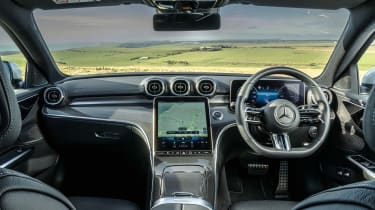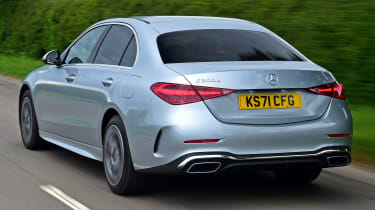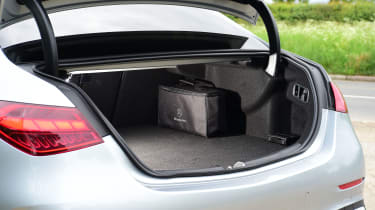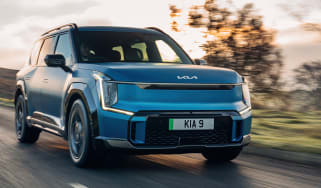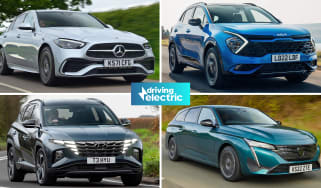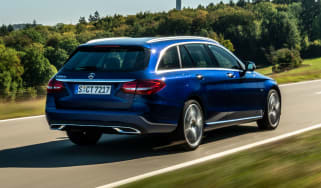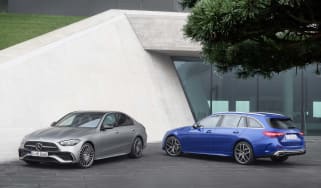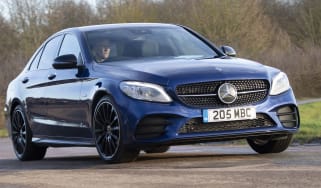Mercedes C-Class plug-in hybrid review
The plug-in hybrid Mercedes C 300 e comes with an impressive infotainment system and 68-mile electric driving range

Pros
- Great infotainment
- Refined and comfortable
- Class-leading electric driving range
Cons
- No 55kW rapid charging for UK buyers
- BMW 330e better to drive
- High starting price
| Car type | Electric range | Fuel economy | CO2 emissions |
|---|---|---|---|
| Plug-in hybrid | 66-70 miles | 471-565mpg | 13g/km |
The Mercedes C-Class is one of the UK’s most popular company cars, and a chief rival to the BMW 3 Series and Audi A4. Like the 3 Series, the C-Class is available with plug-in hybrid power, which promises the performance of a petrol engine with the fuel economy of a diesel.
Compared to the previous generation C-Class plug-in hybrid, the official electric driving range has increased from 35 to 66 miles in the saloon and 70 miles in the Estate, while the average miles-per-gallon figure has jumped from 235 to 471-565mpg. Of course, to achieve this, you’ll need to be charging the battery on a regular basis, so get used to plugging in whenever you’re at home. If you do, you can look forward to an all-electric range that’s likely to be enough for a typical daily commute.
Official CO2 emissions have been slashed in half, too, from an already-low 31g/km to just 13g/km. As a result, company-car drivers can expect big savings, from both a reduction in the C 300 e’s Benefit-in-Kind (BiK) tax rating and from how often you’re likely to need to fill up at the pump.
Under the bonnet is a 201bhp 2.0-litre four-cylinder turbocharged petrol engine that’s combined with a 128bhp electric motor drawing power from a 25.4kWh battery, which for context is larger than the one in the entry-level, fully electric Fiat 500. In our hands the C 300 e delivered a remarkable zero-emissions driving range of 60 miles, which is about double the real-world range of the plug-in 3 Series.
Unfortunately, C 300 e models sold in the UK only come with a Type 2 charging port and a maximum charging speed of 11kW. That means it takes around three-and-a-half hours to top up the battery from a standard home wallbox – not a vast amount of time, but longer than in other European markets. That’s because the plug-in C-Class is available with 55kW rapid charging capabilities in other countries, and at that rate, recharging from 0-100% takes just half an hour – ideal for longer journeys.
Thankfully, the C-Class’s classy interior more than makes up for the lack of rapid charging. The cabin features styling cues and technology from both the S-Class and EQS executive limousines. Swing open the driver’s door and you’re greeted with what can only be described as a typical Mercedes interior, featuring materials that feel just as good as those in the S-Class flagship. Impressive, especially when you consider that S-Class prices start from around £100,000.
The dashboard is dominated by an 11.9-inch portrait-orientated central touchscreen that’s brilliantly responsive and displays Apple CarPlay and Android Auto bigger and better than any of the C-Class's rivals can. It’s also standard on all models, and paired with a 12.3-inch digital driver’s display. Both screens are flanked by five oval metallic air vents that add an industrial-chic feel to the cabin.
Standard equipment specific to the plug-in hybrid model includes pre-entry climate control, a five-metre Mode 3 charging cable for wallbox and public charging stations and the ability to locate and control certain functions remotely.

The C 300 e also features ‘acoustic ambient protection’, which makes it easier for pedestrians to be aware of the car’s presence at speeds of up to 19mph.
You also get the German marque’s familiar ‘Hey Mercedes’ virtual assistant to control most of the car’s functions, which now includes integrated Spotify, Amazon Music and Apple Music, too. It’s one of the better voice-command systems, and means you won’t need to take your eyes off the road, even to adjust the temperature. It’ll improve over time thanks to over-the-air (OTA) software updates, as well.
The new plug-in C-Class's 60-odd-mile range means you’re likely to spend lots of time being propelled by the electric motor alone. Even when you first start the car up, if there’s juice in the battery, you move away in silence. That pure-electric grunt means the C 300 e is quick off the line, too, and offers more than enough speed to keep up with motorway traffic.
If you're unable to top up the battery before it runs out, then, like most plug-in hybrids, the C-Class runs as a full hybrid, with the brakes recovering as much energy as they can to recharge the battery. There’s a set of paddles on the steering wheel to adjust the strength, or you can just switch it off altogether. But, left to its own devices, the intelligent system can tell the car to decelerate more when approaching junctions or if traffic slows down ahead. Some will think it’s very clever, but others will find it a little hard to predict.
Worse than that though is the feel of the brake pedal itself. Like most EVs and PHEVs, the first part of the pedal travel works with the motor regen, while heavier stops are aided by the mechanical brake discs. That initial regen portion of the pedal is very long and very soft, which at first makes it feel as though the brakes simply don’t work. Press harder and the brakes still aren’t particularly reassuring, even though they do bring the car to a halt quickly enough.
If you're on a longer journey and run the battery down, the engine will awake from its slumber. Yet you may struggle to notice its presence, as it only produces a faint hum that's easily concealed if you're playing music or listening to the radio. The steering didn’t provide as much feedback as its BMW rival, and the car is not as sharp overall. But it is very stable at higher speeds, and its ride is ever so slightly softer than the 3 Series – especially on the fairly modest 18-inch alloy wheels of our AMG Line test car.
There are few driving modes you can select: the default one is Hybrid, which we expect most people are likely to leave the car in. There’s a pure-electric mode, and another that maintains battery charge for when you need it most. Unsurprisingly, you also get a Sport mode, which tweaks the steering and throttle response – and instantly fires up the petrol engine. Nonetheless, acceleration in Sport is impressive thanks to assistance from the electric motor, with the car capable of covering the 0-62mph sprint in a little over six seconds and a top speed of 152mph. For context, the non-hybrid C 300 can do 6.0 seconds and 155mph respectively.
Typically, you’d expect a battery as big as the C 300 e's to eat away at cabin space, especially in the rear. However, that’s not the case, and in fact there’s more head, leg and elbowroom than in the old model, with the C-Class remaining the benchmark for comfort in this class.
Boot space is reduced by 140 litres in the standard car to just 315 litres, but that's still a slight improvement over the previous generation and likely to be big enough for most people, with a flat floor, too.
However, if you’re after more space, an Estate version of the plug-in hybrid C-Class is also available. Figures of 360 litres with the rear seats up and 1,375 litres with them folded down are good, but some way short of the 490 litres and 1,510 litres of space you enjoy in non-hybrid versions.
The plug-in C 300 e saloon is available in AMG Line, AMG Line Premium and AMG Line Premium Plus trims, while the Estate version is currently only offered in the range-topping AMG Line Premium Plus specification. Each gets slightly sportier exterior styling than the base cars available elsewhere in the range, as well as a decent amount of equipment to go along with the impressive central touchscreen and digital driver’s display.
However, that means the C 300 e saloon in AMG Line spec is priced at close to £52,000, which is a few thousand pounds more than the facelifted BMW 330e in M Sport trim. Meanwhile, the C-Class PHEV Estate starts from £60,500 – significantly more than its plug-in 3 Series equivalent.
Mercedes has gone all-out with this version of its plug-in hybrid compact exec, adding a realistic 60 miles of electric range, a flagship-worthy infotainment system and comfortable interior to an already appealing package. It’s therefore hard to imagine that any company-car driver who isn’t ready to make the switch to electric will choose one of the C-Class's rivals over this latest iteration. In fact, for that reason the C 300 e has been named Best Plug-In Hybrid Company Car Award for two consecutive years. But we expect private buyers will fall for it just as easily, so long as they can stomach the high starting price.
